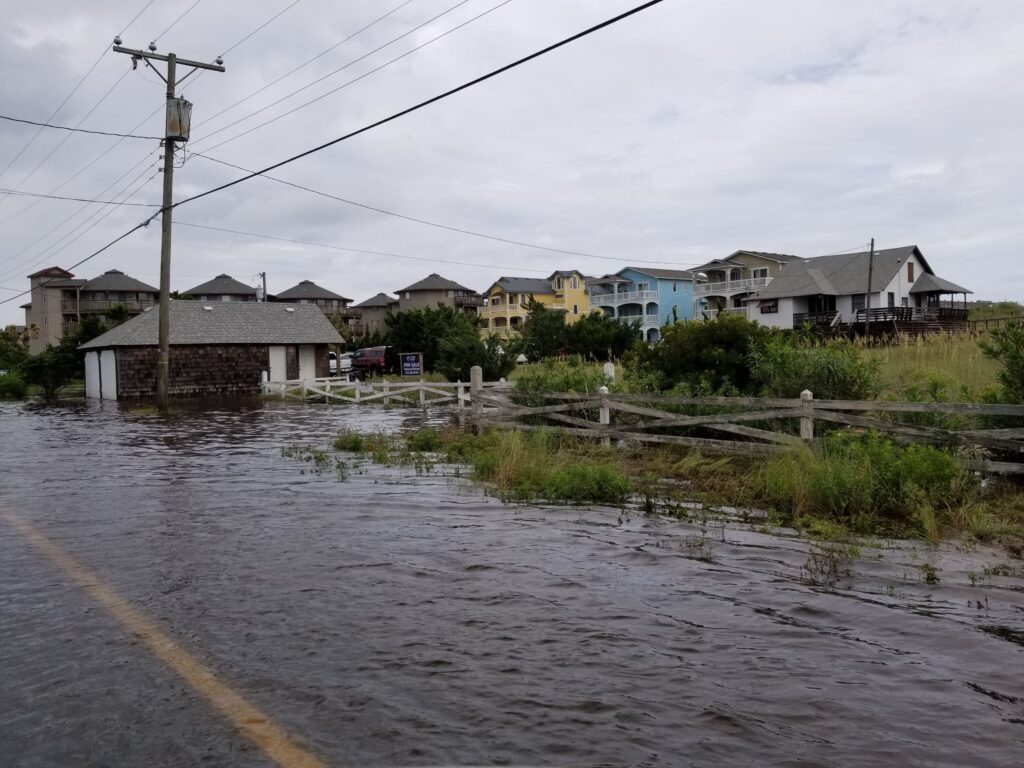Sea-Level Variability

Climate change related sea-level rise is a well-known impact of a warming global climate. And, at the sub-daily or diurnal (over the course of one day) time scale, the gravitational pull of the Moon and the Sun are the main culprits for our high and low tides. However, weather plays an important role on how the sea-level fluctuates between these two timeframes.
Recent research of ours explores the relationships between synoptic-scale weather and this day-to-day variability in our sea-levels – especially along the Atlantic seaboard of the United States.
In Earth’s mid-latitudes, of particular importance are the synoptic-scale scale systems that can impact air pressure and winds over the coastal ocean, and create particularly high or low sea-levels on otherwise innocuous days. Sometimes, this can lead to “sunny-day flooding” or “nuisance flooding” into communities built near the coast.
There are three main ways this occurs: 1) the inverse barometer effect – low atmospheric pressure does not exert as much force on the ocean water as high atmospheric pressure does – thus, the ocean level rises; 2) wind-forcing – a constant wind blowing perpendicularly in towards the coastline forces water to build up into mounds, forcing the ocean level to rise; and 3) wind blowing parallel to the coast can initiate Ekman processes, that can cause either downwelling (and rising ocean levels) as surface water moves horizontally towards the coast, or upwelling (and lower ocean levels) when the opposite occurs.

We have been funded by NOAA’s Climate Program Office and the National Aeronautics and Space Administration (NASA)’s ROSES program on multiple grants to do weather and water research. We have worked extensively with collaborators from the University of South Florida’s Optical Oceanography Laboratory, the National Oceanic and Atmospheric Administration (NOAA), the National Ocean Service (NOS), and the National Centers for Coastal Ocean Science (NCCOS) on projects examining these relationships, along with synoptic climatological relationships between circulation patterns and water clarity.
Check out our StoryMap put together by Doug Pirhalla at NOAA-NCCOS
And our research on these topics continues to evolve. Our next steps include real-time sub-seasonal to seasonal (S2S) forecasting.
Published Research on Weather & Water:
- Lee, C. C., Sheridan, S. C., Dusek, G., & D.E. Pirhalla. 2022. Atmospheric circulation patterns and sea-level variability: Assessing S2S predictability. Artificial Intelligence for the Earth Systems. In Review.
- Pirhalla, D. E., Lee, C. C., Sheridan, S. C., & V. Ransibrahmanakul. 2022. Atlantic Coastal Sea Level Variability and Synoptic-Scale Meteorological Forcing. Journal of Applied Meteorology and Climatology, 61(3), 205-222. https://doi.org/10.1175/JAMC-D-21-0046.1.
- Jacox M. , D. Alexander, D. Barrie, S. Bograd, S. Brodie, A. Capotondi, K. Chen, W. Cheng, E. Di Lorenzo, C. Edwards, J. Fiechter, P. Fratantoni, R. Griffis, E. Hazen, A. Hermann, H. Kim, A. Kumar, Y. Kwon, M. Merrifield, A. Miller, I. Ortiz, D. Pirhalla, M. Pozo Buil, S. Ray, S. Sheridan, S. Siedlecki, A. Subramanian, P. Thompson, L. Thorne, D. Tommasi, M. Widlansky. 2020. Seasonal-to-interannual prediction of U.S. coastal marine ecosystems: Forecast methods, mechanisms of predictability, and priority developments. Progress in Oceanography. https://doi.org/10.1016/j.pocean.2020.102307.
- Sheridan, S. C., C.C. Lee, R. Adams, E.T. Smith, D. Pirhalla, and V. Ransibrahmanakul, 2019. Temporal modeling of anomalous coastal sea level values using synoptic climatological patterns. Journal of Geophysical Research: Oceans, 124. https://doi.org/10.1029/2019JC015421.
- Smith, E., Lee, C. C., Pirhalla, D.E., Ransibrahmanakul, V. Chuanmin, H., Barnes, B. B., S.C. Sheridan. 2019. A synoptic climatological analysis of the atmospheric drivers of water clarity variability in the Great Lakes. Journal of Applied Meteorology and Climatology. doi.org/10.1175/JAMC-D-19-0156.1.
- Capotondi, A., M. Jacox, C. Bowler, M. Kavanaugh, P. Lehodey, D. Barrie, S. Brodie, S. Chaffron, W. Cheng, D. Dias, D. Eveillard, L. Guidi, D. Ludicone, N. Lovenduski, J. Nye, I. Ortiz, D. Pirhalla, M. Pozo Buil, V. Saba, S. Sheridan, S. Siedlecki, A. Subramanian, C. de Vargas, E. Di Lorenzo, S. Doney, A. Hermann, T. Joyce, M. Merrifield, A. Miller, and S. Pesant. 2019. Observational Needs Supporting Marine Ecosystems Modeling and Forecasting: From the Global Ocean to Regional and Coastal Systems. Front. Mar. Sci., 6, 623, https://doi.org/10.3389/fmars.2019.00623.
- Lee, C. C., Barnes, B. B., Sheridan, S. C., Smith, E. T., Chuanmin, H. Pirhalla, D., Ransibrahmanakul, V., R. Adams. 2019. Using Machine Learning to Model and Predict Water Clarity in the Great Lakes. Journal of Great Lakes Research. doi.org/10.1016/j.jglr.2020.07.022.
- Lee, C.C., Sheridan, S.C., Barnes, B.B., Chuanmin H., Pirhalla, D.E., Ransibrahmanakul, V., K. Shein. 2017. The development of a non-linear autoregressive model with exogenous input (NARX) to model climate-water clarity relationships: reconstructing a historical water clarity index for the coastal waters of the southeastern USA. Theoretical and Applied Climatology 130: 557-569. doi: 10.1007/s00704-016-1906-7.
- Sheridan, S. C., D.E. Pirhalla, C.C. Lee, C. C., and V. Ransibrahmanakul. 2017. Atmospheric drivers of sea‐level fluctuations and nuisance floods along the mid‐Atlantic coast of the USA. Regional Environmental Change, 17(6), 1853–1861, https://doi.org/10.1007/s10113-017-1156-y.
- Pirhalla, D. E., Sheridan, S.C., Lee, C.C., Barnes, B.B, Ransibrahmanakul V., and C. Hu. 2016. Water clarity patterns in South Florida coastal waters and their linkages to synoptic scale wind forcing. Satellite Oceanogr. Meteorol. 2, 26–40. https://doi.org/10.18063/SOM.2016.02.003.
- Pirhalla, D. E., Sheridan, S. C., Ransi, V., C.C. Lee. 2015. Assessing cold‐snap and mortality events in South Florida coastal ecosystems: Development of a biological cold stress index using satellite SST and weather pattern forcing. Estuaries and Coasts, 38(6), 2310–2322. doi.org/10.1007/s12237-014-9918-y.
- Sheridan, S. C., and C.C. Lee. 2011. The self‐organizing map in synoptic climatological research. Progress in Physical Geography, 35(1), 109–119, https://doi.org/10.1177/0309133310397582.
